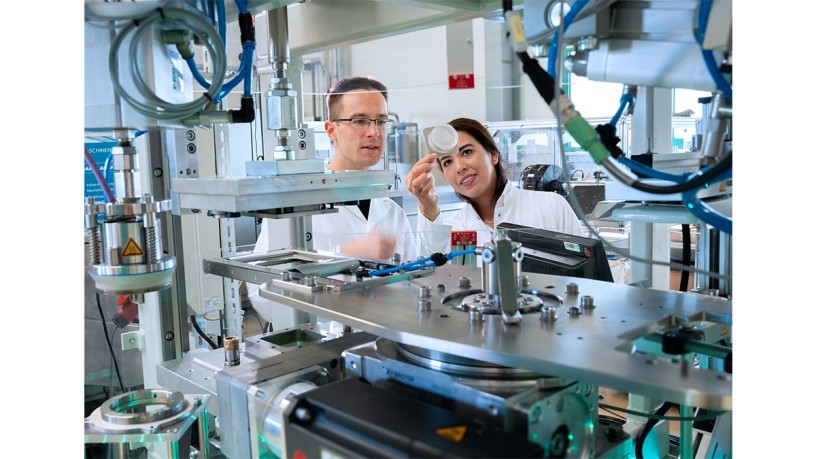Reliable Detection of Organic Eggs
To provide reliable proof of the organic quality of eggs, researchers at the DIL (German Institute of Food Technologies) have further developed an innovative method for testing the quality and authenticity of food and analysed around 4,500 egg samples. Its research project ‘Analysis of the influence of sustainable and organic farming of laying hens on egg quality using H-NMR spectroscopy’, OekoEiSpec for short, was financed by the German Federal Organic Farming Programme (BÖL) with funds from the German Federal Ministry of Food and Agriculture.
Egg yolk extract samples obtained from the eggs were analysed using H-NMR spectroscopy to determine the farming method. Using multivariate data analyses, the researchers identified charac-teristic patterns for each type of husbandry from the spectra generated in this way and created a database and an authenticity model from these reference spectra. By comparing the H-NMR spec-trum of unknown egg yolk samples with the model from reference spectra, it is then possible to identify the actual farming method with an accuracy of 99.9 percent.

© DIL
How widespread is the method of nuclear magnetic resonance spectroscopy in food analy-sis in general, Dr Juadjur?
Nuclear magnetic resonance spectroscopy is being used more and more frequently in food analy-sis. An increasing number of inspection authorities are also using this technology to check the au-thenticity and quality of food. Metabolomics approaches, supported by today's possibilities in the field of artificial intelligence and machine learning, are becoming increasingly popular. These ad-vanced techniques enable very fast, detailed analyses and predictions. However, authentic data is the basic prerequisite for reliable results.
As part of the OekoEiSpec project, you and your team have set up a database with the ref-erence spectra of around 4,500 organic eggs. Will this database be retained in the long term?
Yes, the database with the reference spectra of organic eggs will remain permanently and centrally located at the DIL and will also be accessible to external scientists and laboratories. We will contin-ue to use them to determine the authenticity of eggs and for other research activities.
Under what conditions can external scientists and laboratories access your data?
They can gain access to the data if they submit an application to the DIL with clear scientific or ana-lytical objectives, sign a confidentiality agreement to protect sensitive data and guarantee the cor-rect use of the data. This also includes the willingness to jointly maintain and update the data and to comply with good scientific practice.

© Pixabay - easter-eggs-6035549_1280
Does the DIL offer authenticity testing of organic eggs as a service?
The DIL will offer the proof of authenticity of organic eggs as a service as long as this is economi-cally viable. Interested companies can realise quality assurance including measurement and as-sessment of the samples in the form of test reports and/or a quality assurance label for their eggs.
Which ingredients characterise organic eggs?
Based on current data, some ingredients such as a certain composition of fatty acids, amino acids, carotenoids and cholesterol speak in favour of organic farming, but are not sufficient as the sole characteristic. The concentration of these and other ingredients in the egg is influenced by numer-ous factors, including feeding, the time of year and the health of the hens. These factors vary both within and outside organic farms. This means that the metabolic profiles of organic and convention-al eggs can overlap in some cases. A model as meaningful as the one in our project can only work with a holistic approach that is based on the metabolome and covers as many ingredients as pos-sible. This is also an important realisation of the project, i.e. that valid proof of authenticity is only possible via the totality of the metabolic products in the egg yolk.
H NMR spectroscopy in combination with multivariate data analysis, such as linear discriminant analysis (LDA), makes it possible to recognise complex patterns in the NMR spectra. These pat-terns are characteristic of different farming methods and sources of origin, but unfortunately cannot be traced back to individual ingredients. This means that H NMR spectroscopy overcomes the lim-ited informative value of analysing individual ingredients and offers a reliable way of ensuring the authenticity and quality of organic eggs.

© DIL
Does your database need to be continuously updated to ensure that the results remain ac-curate?
Yes, the database must be continuously updated with new data to ensure a high level of predictive power. Regular updates reflect possible changes in the ingredient profiles caused by changes in production conditions or feeding. This is the only way to maintain the accuracy of the model. At least 400 authentic samples, i.e. at least 100 per type of farming, should be measured each year.
The DIL also analyses the quality and authenticity of plant-based foods using NMR spec-troscopy. Is proof of organic quality also possible here?
Proof of organic quality is also conceivable for plant-based products such as fruit juice, honey and wine, but is not currently carried out by us. In the case of plant-based products, the analysis is more focussed on specific quality-determining ingredients and the detection of regionality and pos-sible adulteration. As plant-based products are not influenced by feeding conditions, it will be more complex to identify organic quality based on the metabolome.
Is the NMR spectroscopy method also suitable for determining the organic husbandry of milk, meat and sausage products?
Our goal is to extend these innovative analysis techniques to meat and other animal products and to investigate other relevant issues, for example in the areas of organic farming, grassland utilisa-tion and animal welfare. We're confident that this method is also very suitable for other animal food products to ensure their quality.



